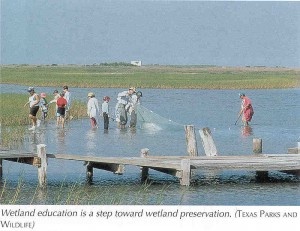Introduction
The Texas Gulf Coast has some of the most abundant and diverse wetlands in the world. Unfortunately, very few of the more than 5 million people who live on or near the coast have any idea what kind of wetlands are near them and why they are important. Many people may actually know more about rainforests in the Amazon than they do about wetlands in their own backyards! The rainforests are important because they are part of the worlds “lungs” – they filter the air. But our coastal wetlands are just as important because they are part of the earth’s “kidneys” – they filter the water! This book introduces readers to Texas’ coastal wetlands by introducing the types of wetlands found here, explaining their importance, and describing where they are found.
This book is not intended as a comprehensive technical work, but rather a general introduction that will give the reader a better sense of Texas’ coastal wetlands. Most of the guide is devoted to the section on regional wetland sites. This section should be useful to educators and others who would like to plan a visit to a regional wetland site. Many site descriptions include internet addresses that provide more detailed information. Additional references are provided on References/Suggested Reading.
This guide describes wetlands found on the Gulf Coastal Plain, a low, flat plain more than 360 miles long and 50 to 100 miles wide that borders the Gulf of Mexico (see map on Major Wetland Types). The area corresponds geologically to the Lissie and Beaumont Geological Formations, deposited during the Pleistocene Epoch starting about 1 million years ago, and the younger Holocene Epoch Formations (no older than 10,000 years), which include sediments adjacent to the coastline and on river floodplains and the Coastal Sand Sheet of South Texas.
